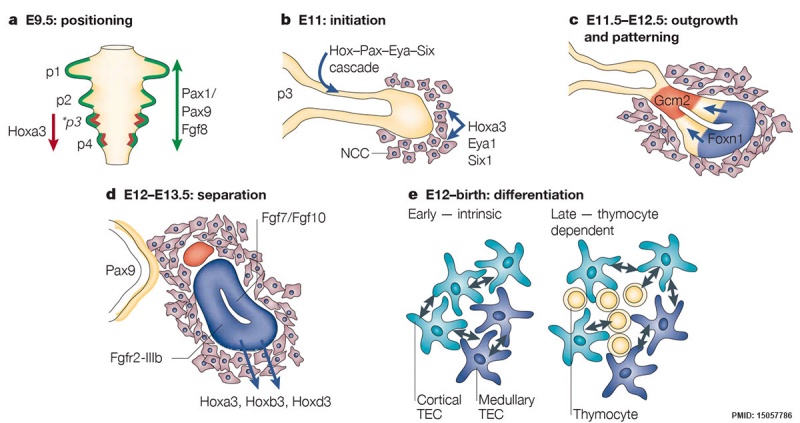File:Mouse model thymus development 01.jpg
From Embryology

Size of this preview: 800 × 423 pixels. Other resolution: 1,200 × 634 pixels.
Original file (1,200 × 634 pixels, file size: 145 KB, MIME type: image/jpeg)
A new Model of Thymus Organogenesis
- Embryonic day 9.5 (E9.5) - positioning
- Paired box gene 1 (Pax1)/Pax9 and fibroblast growth factor 8 (Fgf8; green) are required for pharyngeal pouch formation. Homeobox A3 (Hoxa3; red) is required for third pouch (p3) axial identity, possibly through the Pax–Eya–Six cascade.
- E11 - initiation
- Rudiment outgrowth begins at this stage. The Hox–Pax–Eya–Six cascade is required in the endoderm (yellow); Hoxa3 and Eya1 might also be required in neural crest cells (NCCs).
- E11.5–E12.5 - outgrowth and patterning of the rudiment.
- Regionalization of the rudiment into thymus- and parathyroid-specific domains. This patterning actually begins at E10 with the expression of glial cells missing homologue 2 (Gcm2; red) in the third pouch, controlled at least in part by the Hox–Pax–Eya–Six cascade. High-level expression of forkhead box N1 (Foxn1; blue) begins at E11.25. Lymphoid progenitors (not shown) also begin to arrive at this time, entering the thymus through the capsule by a chemoattractive mechanism.
- E12–E13.5 - separation from the pharynx and migration of the rudiment.
- Pax9 is required for separation from the pharynx. Migration might be controlled by Hox3 genes expressed by NCCs. Separation of the parathyroid from the thymus might be regulated by Gcm2.
- E12–birth - differentiation.
- Foxn1 is required for the generation of all thymic epithelial-cell (TEC) subtypes — cortical and medullary. Initial differentiation is thymocyte independent. Final differentiation requires thymocyte-derived signals, and depends on the Foxn1 amino-terminal domain (Foxn1Delta). Wnt signalling (through the regulation of Foxn1Delta) has been implicated in both autocrine- (TEC–TEC) and paracrine- (TEC–thymocyte) mediated differentiation. The NCC mesenchyme (not shown) might support growth and differentiation of TECs, possibly through fibroblast growth factors, whereas a lymphotoxin-receptor-dependent signalling pathway seems to control late-stage differentiation and maintenance of medullary TECs. Eya1, eyes absent 1 homologue; Six1, sine oculis-related homeobox 1 homologue. (above text from original figure 5 legend)
- Links: Thymus Development
Reference
<pubmed>15057786</pubmed>| Nat Rev Immunol.
Copyright
Reprinted by permission from Macmillan Publishers Ltd: [Nat Rev Immunol.] (Nature Reviews Immunology 4, 278-289 (April 2004) | doi:10.1038/nri1331), copyright (2004)
Cite this page: Hill, M.A. (2024, April 25) Embryology Mouse model thymus development 01.jpg. Retrieved from https://embryology.med.unsw.edu.au/embryology/index.php/File:Mouse_model_thymus_development_01.jpg
- © Dr Mark Hill 2024, UNSW Embryology ISBN: 978 0 7334 2609 4 - UNSW CRICOS Provider Code No. 00098G
File history
Click on a date/time to view the file as it appeared at that time.
| Date/Time | Thumbnail | Dimensions | User | Comment | |
|---|---|---|---|---|---|
| current | 10:38, 25 February 2016 |  | 1,200 × 634 (145 KB) | Z8600021 (talk | contribs) | ==A new model of thymus organogenesis== A new model of thymus organogenesis. Unfortunately we are unable to provide accessible alternative text for this. If you require assistance to access this image, or to obtain a text description, please contact... |
You cannot overwrite this file.
File usage
The following page uses this file: